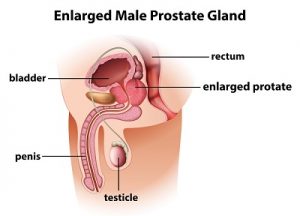 According to a New York Times article, “An enlarged prostate means the gland has grown bigger. Prostate enlargement happens to almost all men as they get older. As the gland grows, it can press on the urethra and cause urination and bladder problems. An enlarged prostate is often called benign prostatic hyperplasia (BPH) or benign prostatic hypertrophy. It is not cancer, and it does not raise your risk for prostate cancer.”
According to a New York Times article, “An enlarged prostate means the gland has grown bigger. Prostate enlargement happens to almost all men as they get older. As the gland grows, it can press on the urethra and cause urination and bladder problems. An enlarged prostate is often called benign prostatic hyperplasia (BPH) or benign prostatic hypertrophy. It is not cancer, and it does not raise your risk for prostate cancer.”
There are many causes of an enlarged prostate, “The actual cause of prostate enlargement is unknown. Factors linked to aging and the testicles themselves may play a role in the growth of the gland. Men who have had their testicles removed at a young age (for example, as a result of testicular cancer) do not develop BPH. Similarly, if the testicles are removed after a man develops BPH, the prostate begins to shrink in size.”
The symptoms are, “Lower urinary tract symptoms (LUTS) are categorized either as voiding (formerly called obstructive) or storage (formerly called irritative) symptoms. BPH is often, but not always, the cause of LUTS, especially the voiding symptoms.
Other medical conditions, such as bladder problems, can also cause these symptoms. Some men with BPH may have few or no symptoms. The size of the prostate does not determine symptom severity. An enlarged prostate may be accompanied by few symptoms, while severe LUTS may be present with normal or even small prostates.”
Furthermore, “Voiding symptoms can be caused by an obstruction in the urinary tract. They are often due to BPH. (Obstruction is the most serious complication of BPH and requires medical attention.) Voiding symptoms include: A hesitation before urine flow starts despite the urgency to urinate, Straining when urinating, Weak or intermittent urinary stream, A sense that the bladder has not emptied completely, dribbling at the end of urination or leakage afterward.”
And, there are also other symptoms, “Urinary retention (inability to void) is a serious symptom of severe BPH that requires immediate medical attention. Urinary retention can be a sign of obstruction in the bladder. Bladder obstruction can cause bladder stones, urinary tract infections, blood in the urine, and incontinence.”
Finally, “Storage symptoms, also referred to as filling symptoms, include: An increased frequency of urination (every few hours), particularly at night, An urgent need to urinate and difficulty postponing urination, Painful or burning sensation when urinating”
Doctors have numerous ways of finding out whether your prostate is enlarged. For example, “After taking a complete medical history, your doctor will perform adigital rectal exam to feel the prostate gland. “ Furthermore, “you may be asked to complete a form to evaluate the severity of your symptoms and their impact on your daily life. Your score may be compared to past records to determine if the condition is getting worse.”
The recovery process requires some self care, “The choice of a treatment is based on the severity of your symptoms, the extent to which they affect your daily life, and the presence of any other medical conditions. Treatment options include “watchful waiting,” lifestyle changes, medication, or surgery.
If you are over 60, you are more likely to have symptoms. But many men with an enlarged prostate have only minor symptoms. Self-care steps are often enough to make you feel better.”






